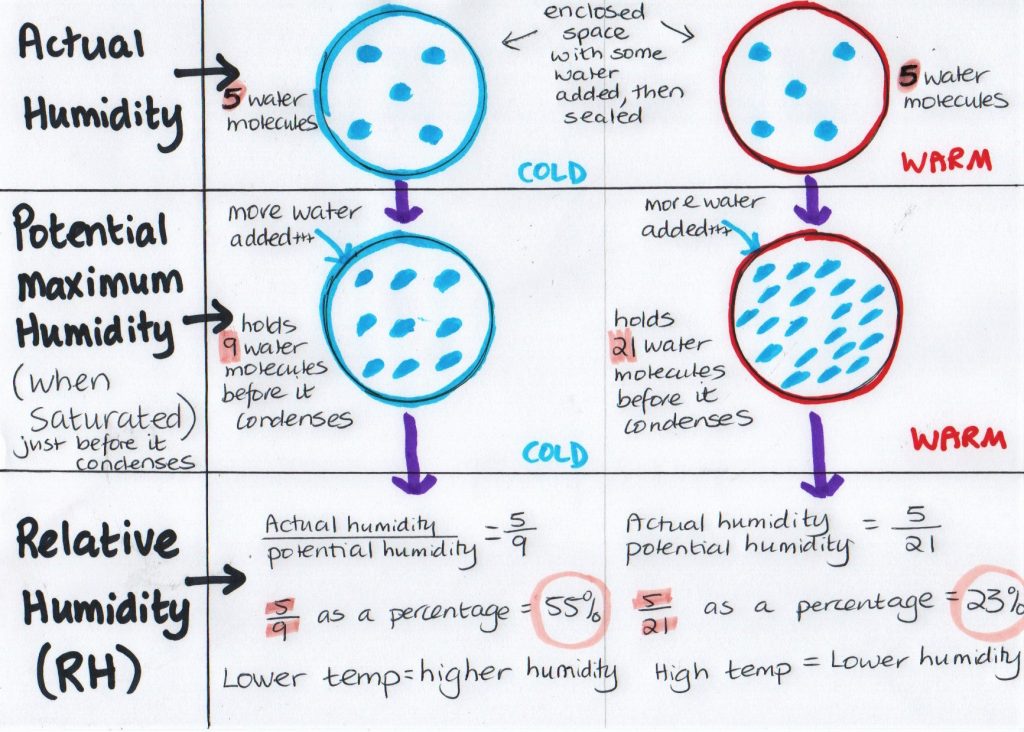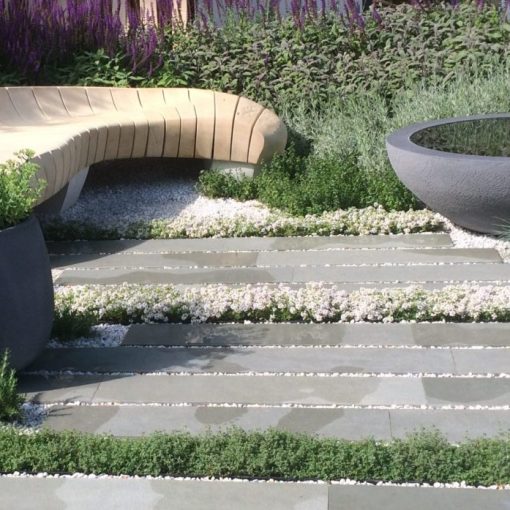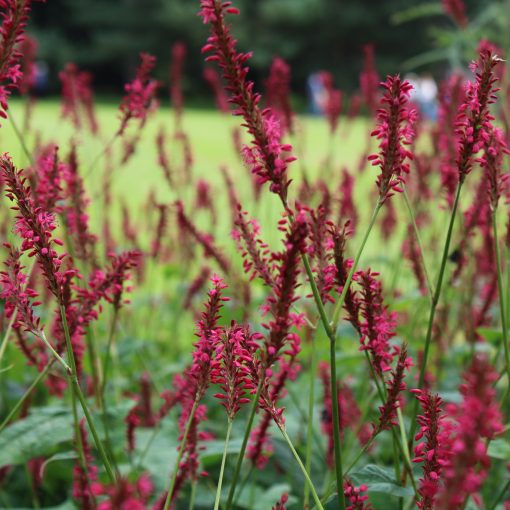R2114 Learning outcomes
4.3 Describe methods of changing the relative humidity (RH) in a protected environment, including the effects of ‘damping down’, ventilation and temperature changes. State what is meant by ‘damping down’. Describe patterns of ventilation in a structure which will help adjust relative humidity. The use of forced draught or fan ventilation and natural ventilation systems. Describe how changes in temperature affect relative humidity which in turn affect water and nutrient uptake.
Introduction
A protected structure such as a greenhouse, polytunnel, cloche or cold frame is an enclosed environment and must be managed carefully as it is an artificial environment. It can become extremely hot and dry or pest and disease ridden very quickly if mis-managed. It is also a place where lots of disorders are seen as successful growing under protection is all about controlling the environment and when this goes wrong disorders will be abundant. This blog focuses on humidity within protected structures and how this is controlled for optimum plant growth.
Introduction to some terms before we study relative humidity
To understand relative humidity and how humidity levels affect the greenhouse, polytunnel or cloche environment we must understand the process of diffusion and transpiration. From now on I will just refer to the protected environment as a greenhouse but remember we mean all protected structures.
If you have studied the science module you will have covered these processes. If not here is a summary:
Diffusion =
Movement of a substance (gas or liquid) from an area of high concentration to an area of low concentration. The substance will spread out evenly in the given space. Think about a scented candle burning in a corner of a room. The scent will be strong at first in the corner of the room and after a few minutes there will be a faint smell everywhere in the room as the aroma has spread out evenly. This process does not require energy. Water can diffuse from an area of high to an area of low concentration and does not require any energy to do this.
Transpiration =
Evaporation of water vapour from the leaves and other plant surfaces into the atmosphere. The water exits the leaf via small holes, mainly on the underside of leaf called stomata and also through the leaf surface.
Transpiration is a form of diffusion.
Water uptake =
Water uptake is obviously important for the following reasons:
- Adequate water means cells are turgid and leaves are held horizontally rather than wilting, so they are exposed to sunlight for maximum photosynthesis.
- Water is required for transport of nutrients in solution from the growing medium across the roots, up through the stem and to all parts of the plant. Nutrients are essential for healthy growth.
- When water is lost by transpiration it creates a pulling force called the transpiration pull which is a force which drags the columns of water up through the stems. Plants have to lose water to be able to take it up. So transpiration facilitates water uptake.
Summary diagram for diffusion, transpiration and water uptake:


What is relative humidity?
Relative humidity (from now on written as RH) =
is the amount of water vapour in the air relative to the total amount of water the air can hold at a given temperature.
Relative humidity is the amount of moisture in the air compared to what the air can potentially “hold” at that temperature. When the air can’t “hold” all the moisture, then it condenses as dew.
In relation to the leaf:
- The more moisture in the air around a leaf (ie the higher the RH) the slower the rate of transpiration because there is less difference between the water concentration within the leaf and the water concentration outside the leaf (when there is little difference / little gradient there is little movement).
- As the RH in the air outside the leaf decreases (becomes drier) then the rate of transpiration increases as there is a bigger difference between inside and outside the leaf.
- RH can range from 100% (meaning the air is saturated and holding as much water as it can at that given temperature) to 0% meaning the air has no moisture at all.
- Most plants have a preferred RH level 40-75% or higher for those native to the tropics.
In commercial greenhouses humidity is monitored closely with either a hygrometer or a humidistat.
Relative humidity is linked to temperature.
Relative humidity decreases as temperature increases. (with the same moisture levels)
Remember when we defined RH, temperature was part of the definition. Warm air can hold more water than cold air before it becomes saturated and the water vapour turns into liquid (condenses). Think about how water drips from aluminium greenhouse frames in Winter yet in Summer it does not. That’s because it is colder and the water vapour turns to liquid.
If the amount of moisture in an enclosed space is the same, the relative humidity will be lower when temperatures are higher.
Now if you are like me you want to understand why RH and temperature are related in this way. Do you need to know why? No. Could I find an easy way to explain it in words? No.
If you are prepared to accept that RH is inversely proportional to temperature, skip the next diagram. My best effort to explain is this diagram below:


Now we understand the science behind how water behaves at different concentrations and different temperatures, what practical methods do we use to control humidity in the greenhouse and WHY?
First of all WHY do we want to control RH in the greenhouse? Both Too Dry and Too Wet Are Bad, and requirements vary depending on the plants being grown.
If the relative humidity is very HIGH
- The rate of transpiration will slow and the plant will not wilt.
- For stem cuttings the leaves will lose less water giving the roots time to grow.
- For seeds keeping a lid over the seed tray will reduce the need for watering as less evaporation from the surface of the compost will occur so water is saved.
- Fungal diseases such as damping off diseases and grey mould will thrive as they prefer humid environments. Chemicals will need to be used to control this.
- Red spider mite will not thrive as it prefers dry conditions.
- One of the benefits of increasing humidity levels by the various means like damping down and misting is that as the water turns from a liquid to a gas energy is used which will lower the temperature in the greenhouse.
If the relative humidity is very LOW (Dry atmospere)
- The pest red spider mite will thrive. Chemicals may be needed to control this.
- The transpiration rate will be high and plants will lose water faster than they can replace it and will wilt and possible die. Water stress will also reduce the rate of photosynthesis which will slow the rate of growth.
- Periods of water stress can lead to particular disorders such as blossom end rot in tomatoes and peppers which is due to the fact that calcium has not be carried in solution to the growing points of the plant.
- Fungal diseases will not thrive.
- Stem cuttings will lose too much water from their leaves before roots have had chance to form, and the cutting will not be successful.
- Seeds may not emerge as they start to germinate and then dry out.
How does the grower control relative humidity?
In commercial settings the humidity levels are monitored by sensors around the structure and this information is fed into a computer which then responds by opening vents or turning misting units on for example.
For us mere mortals here are ways to manually increase and decrease the humidity in the greenhouse.
To increase the relative humidity:
1. Damping down.
RH can be increased by adding moisture to the air which is often done by damping down. This is wetting concrete floors and benches by spraying water. As this water evaporates it results in more moisture in the air thus raising the relative humidity.
2. Misting/fogging system
Very fine droplets of water are sprayed into the air which evaporate thus raising the relative humidity. This system is used in systems when taking stem cuttings to prevent wilting through excessive transpiration. It will also decrease the ambient temperature in the greenhouse. Fogging and misting are very similar. Fog droplets are much finer and hang in the air for longer.
This video shows fogging:
https://www.youtube.com/watch?v=bMwuYmSsQI4
3. Spraying with a hand spray
This is a small-scale way of increasing humidity and is very useful for house plants grown on window sills and conservatories. Ferns in particular benefit from spraying as they lose water from their thin leaves rapidly.
4. Lower the temperature
Turn off the heating or use a fan set on cold.
5. Group plants together
In conservatories for example, group plants close together so that water becomes trapped in the mini habitat which is created resulting in higher humidity.
6. Stop water vapour escaping
Cuttings and seeds can be covered with a plastic bag or lid to keep the atmosphere around them humid.
To decrease the relative humidity:
1. Increase the heat
Raising the air temperature will reduce the relative humidity. Turn heaters on or insulate the greenhouse in Winter so that heat is not lost. Humidity may build up at night when temperatures drop, so some heat at night will lower RH and prevent build up of disease.
2. Increase ventilation
If doors or vents are open, water vapour will escape as the hotter air rises and escapes through openings.
Ventilation can be forced or natural.
a) Natural ventilation systems
A passive process harnessing the power of wind to mobilize air though the structure. Includes roof vents, side vents, louvre panels, opening of doors. Cannot be controlled as easily as automated systems and is more variable. Cool air enters near ground level and hot humid air leaves via roof vents (as warm air rises).


Diagram above showing natural ventilation which does not require energy.
b) Forced ventilation systems
A powered system whereby cool air enters the glasshouse via inlets at one end of the glasshouse and hot air leaves the structure via a powered extractor fan at the other end. This creates a continual flow of air through the structure and is more constant and controllable. It is an active process requiring energy to drive it.


Diagram above to show active ventilation with a fan ‘sucking out the air’
This video compares the different types of ventilation (passive and forced) in a commercial greenhouse.
https://www.youtube.com/watch?v=ee9jjxgwBHU
Advantages of increased air movement (ventilation)
- Decreased humidity
- Cools the greenhouse down as the hot air rises and escapes and is replaced by cooler air.
- CO2 can enter so is never a limiting factor for photosynthesis
- Reduced chance of disease.
- Greenhouse is more comfortable to work in.
3. Install a dehumidifier
This video describes how the dehumidifier works and gives a good overview of humidity.
https://www.youtube.com/watch?v=jFfnzOchZ7E
4. Space plants out so they are not overcrowded and not trapping humid air.
Here is a summary diagram showing practical ways to increase and decrease relative humidity in an enclosed structure. (As listed above)


How is water and nutrient uptake affected?
As RH increases, transpiration rate decreases. Transpiration creates the transpiration pull which pulls water and nutrients up the stem, so changing RH or temperature can indirectly affect water and nutrient uptake. Blossom end rot is a prime example of how fluctuating water levels can lead to calcium deficiency which causes blossom end rot.
Ever wondered if your neighbours are watering your tomatoes properly while you are on holiday? Tomatoes can wilt and look dead but then recover when watered so you may be none the wiser when you return home. However the symptoms of blossom end rot later on will tell whether they did a good job or not!


Naughty neighbour did not water my plants properly – or was it high humidity which decreasd the transpiration pull force? Lack of water causing lack of calcium, causing blossom end rot.
Finally
Humidity can not be considered in isolation when managing a greenhouse. Methods used to reduce humidity will also cool down the greenhouse. (ventilation, misting, hand spraying). As well as optimum plant growth, humidity is controlled to reduce the risk of diseases occurring. The levels of humidity will be determined also by the type of plant being grown. Cacti for example require much lower humidity levels.
Further reading
https://ag.umass.edu/greenhouse-floriculture/fact-sheets/reducing-humidity-in-greenhouse






